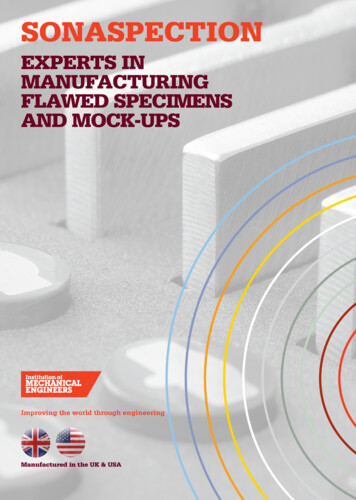
Transcription
2. Building Blocks of the Climate SystemLet’s explore fundamental physical properties of the earth system which provide insightinto how the climate system works. Progressing outward from the sun, Mercury and Venus aretoo hot and Mars is too cold, but Earth is located in a fairly narrow “sweet spot”, where watercan exist in its liquid, solid, and vapor form. The properties of different elements and moleculesdetermine the composition of the earth system spheres, their radiative effects in the climatesystem, and effects on the biosphere. Temperature, pressure, and density help us understandhow the atmosphere and ocean behave. Different parts of the electromagnetic spectrum areresponsible for different global change issues. Absorption and emission of electromagneticradiation determine the temperature of our planet. Differences in heating give rise to winds andcurrents, which transport quantities around in the general circulation of the atmosphereand ocean.About half of the molecules in our atmosphere lie below 5 km altitude, which is quitethin compared to the radius of the earth. Winds near this altitude steer weather systems. Thepattern of continental-scale waves in the upper troposphere provides a way for the state of theweather in one part of the world to be communicated to other parts of the world. These longdistance dynamical relationships are known as teleconnections. Most of the infrared photons thatescape to space are emitted from near 5 km altitude in the atmosphere. Electronic properties ofmolecules help us to understand how they interact with different parts of the electromagneticspectrum. We will use simple laws of physics to calculate the strength of the naturalatmospheric greenhouse effect. This may be contrasted with an actual greenhouse, where theroof serves to keep heated air in the greenhouse. The anthropogenic greenhouse effect is thedegree to which the natural atmospheric greenhouse effect is augmented by our increasedemissions of radiatively-active trace gases.2.1 Important ConstituentsConsideration of the atomic structure of the elements provides insight into fundamentalproperties of the earth system. Metals have many protons and neutrons and like to shareelectrons, which makes them dense. They are very common in the asthenosphere andlithosphere, which underlie the ocean and atmosphere. Quartz (SiO2) is a very common crustalmineral (Table 2.1). Ca is often found in calcium carbonate, CaCO3, or limestone, which is abyproduct of life in the ocean. The diversity of minerals has increased along with diversityof life forms over geological time. In the periodic chart of the elements, those in the right-handcolumn, such as Ar, have no unpaired electrons, are quite unreactive, and do not bind to othermolecules. These noble gases exist in significant quantities in the atmosphere.Lithosphere47% O28% Si8% Al5% Fe4% CaOcean55% Cl#30% Na&8% SO*)4% Ma1% KAtmosphere78% N221% O21% Ar0-4% H2O0.04% CO2Table 2.1. The five most common components in the lithosphere, ocean, and atmosphere.20
Electrons love to be paired up. Elements in the second column from the right in theperiodic chart have more compact and powerful nuclei than others to its left in the same row, andare good at attracting weakly-held electrons, readily becoming negatively charged ions. Elementsin the left-hand column have nuclei that are less strong and often lose their outermost electron,becoming positively charged. As a result, Na& and Cl# and other ions are common in the oceanand in life forms (Table 2.1). O, N, and C like to share multiple electrons and, together with H,make strong bonds that are useful for storing and manipulating energy in living organisms. Inthe atmosphere, N2 and O2 are unreactive at typical earth temperatures and are quite abundant(Table 2.1). Shortly we will examine the question of how relative abundances in the atmosphereevolved over geological time.Special nutrients P, K, and N are important for life. The electronic properties of metals, insome cases, enable essential metabolic processes such as respiration (Fe) and photosynthesis(Cu). Others, such as Hg, Cd, Pb, and Al, can interfere with normal biomolecular functioning forboth animals and plants. Although CO2 is the fifth most common atmospheric gas, there ismuch more carbon in the ocean than in the atmosphere. With increasing anthropogenic CO2being emitted into the atmosphere, more CO2 is dissolving into the oceans. When CO2 dissolvesit creates carbonic acid (HCO3), which increases the acidity of the ocean. Diatoms are able tomake use of the dissolved silicon and oxygen in the ocean to make their shells out of opal (SiO2).They dominate the base of the food chain in colder oceans. Coccolithophores make their shellsout of calcium carbonate (CaCO3) and dominate the base of the food chain in midlatitudes.Increased acidity can shift the balance between major ecosystems in the ocean by tending todissolve calcium carbonate shells, allowing the diatom ecosystem to expand at the expense of thecoccolithophores and all of the life forms that they support.In the atmosphere, the most common gas after N2 and O2 is H2O, which varies from 4%in the humid tropics to almost 0% in coldest regions. Since H2O is a polar molecule, it has arotational dipole, with a plus charge near the hydrogen nuclei and a minus charge near thestronger oxygen nucleus, which is able to attract the electron cloud nearer to it. At earthtemperatures, all molecules rotate and vibrate. Molecules with an electric dipole are specialbecause they have an oscillating electric field, with quantized energy states. This enables suchmolecules to readily absorb and emit quantized packets of energy corresponding to specificwavelengths of infrared radiation. The quantization of emitted and absorbed radiation is evidentin observed line spectra, where the wavelength of light corresponds to specific energy amounts.More complex molecules such as N2O or CFCs have more vibration/rotation modes, moreabsorption lines and more wavelengths, and are therefore more potent greenhouse gas molecules.But since water is so plentiful, it is the most important greenhouse gas. Clouds and aerosols alsoabsorb and emit infrared efficiently. Together with water vapor, they help keep the planetcomfortable for life on earth. N2, O2, H2, and the noble gases are symmetric and lack a rotationaldipole, hence they are bad at absorbing and emitting infrared radiation and make very poorgreenhouse gases.Table 2.2 highlights some of the primary chemical actors on the stage of climate change.The first group includes relatively long-lived compounds which are relevant to greenhousewarming and ozone depletion. The second group is important in regional air pollution problems.21
Constituentcarbon dioxidemethanenitrous oxidechlorofluorocarbonsstratospheric ozonetropospheric ozonecarbon monoxideodd nitrogenodd sulfurhydroxyl radicalFormulaCO2CH4N2 OCFCsO3O3CONOxSOxOH #Concentration410 ppmv1.7 ppmv0.3 ppmv3 ppbv1-10 ppmv0-200 ppbv0-100 ppbv0-50 ppbv0-50 ppbv10-11Sourcecombustionland ncombustioncombustionLifetime4 years10 years170 years80 yearsweekshoursmonthsdaysdays10-3 secTable 2.2. The major climatically important trace gases in the atmosphere, with theirconcentration, source, and lifetime. The chemical lifetime of a constituent is defined to be theamount of that constituent in the atmosphere divided by its loss rate. For CO2, the loss rateconsidered is due to photosynthesis.The long-lived greenhouse gases CO2, CH4, N2O, and CFCs have many vibration-rotationmodes and are therefore excellent at absorbing and emitting infrared radiation. CFCs also reducestratospheric ozone, letting more harmful UV reach the surface. In polluted air, members of thesecond group directly affect human health. Tropospheric ozone exceeding 65 ppbv is bad forhuman lung tissue and is associated with significant mortality. Odd nitrogen (NOx NO NO2)and odd sulfur (SOx SO SO2) form nitric acid (HNO3) and sulfuric acid (H2SO4), whichreadily dissolve into hydrometeors. These fall out as acidic precipitation, harming ecosystemsand human creations. NOx and SOx tend to rain out within a week or so. Considering typicalwind speeds, acid rain tends to spread downstream of sources over continental scales. Thehydroxyl radical (OH) plays an important role in partitioning species within chemical families.OH # is essential for converting source pollution gases such as NO2 and SO2 into precipitabledissolved acids, and is therefore known as the “tropospheric cleanser”. Increasing emissions ofCO and CH4 can reduce OH # and thereby hamper its ability to cleanse the atmosphere of otherpollutants.Focus: A Breath of AirIf you release dye into the air, it will quickly mix with its surroundings.Turbulent motions, at scales ranging from centimeters to thousands of kilometers,transport air molecules and small particles around and mix them with theirsurroundings. Within a year, long-lived trace constituents are well-mixed throughoutthe troposphere.An application of this principle to a single breath of air vividly emphasizes theinterconnectivity of the earth system. Take in a breath. It is approximately 1 liter ofair. At sea level near room temperature, 22 liters of air contain Avogadro's numberof molecules: 6x1023 molecules. This means that your breath contains 3x1022molecules! You may now exhale. After one year, the molecules from your breathwill be spread evenly throughout the troposphere. How dilute will they be? Tofigure that out we need to know what the volume of the atmosphere is. If we could22
compress the atmosphere uniformly to sea level pressure, it would be about 8 kmthick. The surface area of the earth is 4 𝜋 (6x106 m)2, so the volume of the air atsea level pressure would be 3 x 1018 m3 or 3x1021 liters. If you divide the numberof molecules in your breath by this volume there should be at least 10 molecules perliter! Each breath of air spread throughout the atmosphere would provide about 10molecules for every liter sampled. Of course, your exhaled molecules may beincorporated into other parts of the earth system. You are inhaling molecules fromall parts of the biosphere. Each breath contains molecules from every breath that youand every other organism exhaled last year.We all share the same molecules eventually. Each of our exhalations literallybecomes, molecule by molecule, one with the earth system, while each breathliterally merges molecules from everything else into ourselves. It is hard to escapethis molecular reality of the interconnectedness between large and small. Heroes andvillains, plants and animals, all have shared some of the same molecules with you.By taking in air, water, and food, and metabolizing many of the molecules, ourbodies are thought to replace approximately half of our molecules each year. It issort of amazing that our appearance doesn't change very much. This steadyinterchange of molecules illustrates one facet of interconnectedness in the web oflife.2.2. TemperatureOne important descriptor of climate is temperature, which is related to how fastmolecules are moving, which depends on the amount of internal energy. At room temperatures,molecules travel at an average speed of 450 m/s in random directions. (Coincidentally, this issimilar to the eastward speed of the earth's surface at the equator.) The Fahrenheit and Celsius(or Centigrade) temperature scales are based on phase change of water substance, while theKelvin temperature scale is based on the concept that absolute zero represents a state of zerointernal energy. This zero reference point of the Kelvin temperature scale is an essentialfeature for successful application in all scientific calculations. The Kelvin enjoys full honoralongside the meter, the second, and the kilogram as a fundamental unit in the SystemInternationale (SI).Some insight into the Fahrenheit scale may be had by driving in the wintertime inWisconsin, where they salt the roads. If it is below 0 F on your way to work, then there isusually a powdery white film on the roads. If it is above 0 F on your way home, then it isprobably glistening wet. 0 F is defined to be the coldest temperature that a mixture of salt, ice,and water can be. The freezing point is 32 F for unsalted water, with180 gradations or degreesfrom freezing to the boiling point at 212 F. The Centigrade scale employs 100 degrees betweenthe freezing point of water (0 C) and boiling point (100 C). You may convert back and forth byusing C 5/9( F - 32) and F 9/5 C 32. The Kelvin scale retains the 100 degrees betweenfreezing and boiling, but starting from absolute zero, freezing doesn't occur until 273 K, so K C 273.Pure water will not freeze until 233 K unless it comes in contact with a foreign particle orsurface capable of initiating condensation. (Coincidentally, this occurs where the Fahrenheit andCentigrade scales cross at -40 F -40 C.) This means that a mud puddle won't freeze at 32 Fwithout the mud particles. This also means that snowflakes and raindrops cannot form in the air23
above -40 F without smoke, dust, or other aerosols to act as nuclei [e.g., Wallace and Hobbs,1977]. Ultimately, forest fires and windblown soil enable precipitation to fall from the sky.How does the temperature of the earth compare with Venus and Mars? The earth'saverage surface temperature is 288 K (15 C, 59 F), about 35 K warmer than it would be withoutan atmosphere. The surface temperature of Venus is 750 K, while that of Mars is 215 K.Venus suffers from a runaway greenhouse effect due to 90 earth atmospheres of CO2. Theatmosphere of Mars is less than 1% of the earth's atmosphere. Its temperature is almost thesame as if it had no atmosphere at all. To better understand these striking differences, we need toconsider the transfer of electromagnetic energy.2.3. The Electromagnetic SpectrumIn order to understand ozone depletion and the atmospheric greenhouse effect we need toconsider the range of wavelengths emitted by matter in the universe, the spectrum ofelectromagnetic radiation, or light. Light is envisioned to have a wave-particle nature, with aphoton having a specific wavelength characterized by an oscillation between electric andmagnetic fields. The oscillation's wavelength is precisely related to the discrete amount ofenergy associated with the photon. Shorter wavelengths correspond to more energetic photons.The precise amount of energy in a photon corresponds to the amount of energy that was lost bythe emitting molecule, whose vibration, rotation, and electronic states are quantized. Onceemitted, light travels at 3x108 m/s, until absorbed by another molecule, which can only absorbthe photon if it can increase its energy level by the exact quantum of energy corresponding to itswavelength. Therefore, the ability of a molecule to absorb and emit electromagnetic radiationdepends on its unique structure and energy states. Indeed, the spectral absorption features ofevery molecule provide a unique “fingerprint” for identifying their presence, which is useful inmonitoring concentrations. Absorption spectra are crucial for quantitative calculations of heatingrates.High EnergyWavelength in microns (µm)10-6 10-3 10-2 0.2 0.3 0.5 0.74nearIRx rays XUV UV visible Low Energy10310610IR microwaves radiowavesFigure 2.1. The electromagnetic spectrum. The energy of a photon is inversely proportional toFigure 2.1. The electromagnetic spectrum. The energy of a photon isits wavelength.inversely proportional to its wavelength.Figure 2.1 shows how we categorize different parts of the electromagnetic spectrum bywavelength, ranging from very short, energetic x-rays to very long, mellow radio waves. Thewavelength of light is often given in microns, or millionths of a meter. The most commonlyemitted photon from the sun, yellow light, is about 0.5 microns (0.5 𝜇m), or 0.5x106 m24
wavelength. 1 micron is about 1/1000th the width of a pencil stroke. One micrometer 1 𝜇m 10-6 m 1 micron 103 nanometers 104 Angstroms. The diameter of N2 and O2 molecules isabout 0.001 𝜇m, so visible light doesn't interact strongly with most air molecules. We haveevolved to see in the visible part of the spectrum because the photosphere of the sun, being 6000K, emits most of its energy in the visible. The familiar spectrum of light visible to humansranges from the shortest, violet (0.3 𝜇m), to blue, green, yellow, orange, and the longest, red (0.7𝜇m). Plants present flowers which are attractive to humans in the visible, but also to insectswhich see in the UV (0.1-0.3 𝜇m). XUV and x-rays are found at even shorter wavelengths.Toward longer wavelengths from red one encounters near-IR (0.7 - 4 𝜇m), IR (4 - 100 𝜇m),microwaves (cms), and radio waves (meters). Objects at earth temperature emit energy primarilyin the IR near about 10 𝜇m.For human color vision, there are three photo-pigments in the cone cells of the eyes thatexhibit three distinct light absorption curves sensitive to violet, green-yellow, and yellow[Mollon 1995]. About 6% of males have photopigments with green-yellow and yellowabsorption curves closer together, while another 2% of males lack the green-yellow photopigment altogether. Thus, 1 out of 12 males see the world differently than the rest of humanityand the perception of color is rooted in specific molecules. Some scientists have speculated thatthese males may be better at perceiving shades of gray near twilight, with superior huntinghaving allowed them to succeed. Specific molecules are often at the root of irreducible sensoryimpressions, imparting a distinct noumenal essence. Other examples will be discussed inChapter b) percentabsorptionfor the wholeFigure2.2.a) Thea) Thesolaremissionspectra,b) percentabsorptionfor the wholeatmosphere,absorptionfor forthe thepartpartof thethat lies11 km. 11 atmospherethe atmospherethatabovelies above25
Figure 2.2 zooms in on the middle part of the spectrum in Figure 2.1, from 0.1 to 100 m,which includes most of the solar and infrared energy emitted from the sun and the earth.Compare the spectrum of electromagnetic energy emitted from the sun (at 6000 K) to thatemitted from the earth (at 255 K). For both the sun and the earth, the power output depends onwavelength. The average wavelength of emission is much shorter for the sun than for the earth.There is a clear separation near 4 m. Shortwave radiation is solar radiation, which peaks in thevisible part of the spectrum, being characterized by wavelengths near 0.5 m, or yellow.Longwave radiation is earth radiation, which peaks in the infrared part of the spectrum, beingcharacterized by wavelengths near 10 m. This separation is useful in discussing the greenhouseeffect. Atmospheric molecules interact quite differently with visible and infrared radiation. Airis nearly transparent in the visible, letting the sun heat the surface, but some kinds of moleculesabsorb well in the infrared. It is the interplay of infrared and visible energy that constitutes thegreenhouse effect.The curves in Fig. 2.2 have been drawn to have the same area underneath them, to signifythe balance of absorbed solar radiation, at the earth's distance from the sun, and emitted infraredradiation in determining the temperature of the earth. To show how much power is emitted fromthe surface of the sun compared to the surface of the earth, the curve on the left would have to bemade some 300,000 times larger, completely dwarfing the curve for emission from the earth. Thepower of energy emitted from the photosphere of the sun is 70 million W m-2 at 6000 K, whilethe power of energy emitted from the earth is 240 W m-2 at 255 K. The power of emittedenergy increases very rapidly with increasing temperature, being 390 W m-2 for emission at 288K. This relationship is captured by the Stefan-Boltzmann Law,𝐸 𝜎 𝑇) ,(2.1)where 𝜎 5.67x10-8 W m-2 K-4 is the Stefan-Boltzmann constant, T is in Kelvins, and E is thepower of emitted radiation in W/m2. This very strong dependence of emission on temperature isan essential brake in the climate system which keeps temperatures from becoming extreme, atopic that we will return to shortly. It constitutes a strong negative feedback to a temperaturechange.About 2% of the solar energy is in the form of ultraviolet light (UV, 0.2-0.3 𝜇m). In therarefied stratosphere, this small amount of total energy that is absorbed by ozone causestemperatures to increase upward. UV photons are individually far more energetic than visible orinfrared photons, which is why they are dangerous to biomolecular processes. It is good thatozone in the stratosphere absorbs most of the UV, protecting life on earth. Since less than 2% ofthe solar energy is UV, the amount of ozone doesn't have a strong influence on the temperatureof the planet. That is determined by the other 98% of the energy that is in the visible andinfrared. Thus, the ozone hole is a very different problem and does not cause anthropogenicgreenhouse warming.Perhaps the most striking aspect of Fig. 2.2 is the distinct difference between the averagewavelength for solar versus earth emission. This inverse relationship between the temperature ofthe emitting body and the wavelength of emitted radiation makes intuitive sense. If you take arope and shake it up and down quickly you will observe short waves moving away from youalong the rope. If you do it less energetically, longer waves will move along the rope. Hottermolecules are more energetic and will emit more energetic photons of shorter wavelength.26
Cooler molecules are vibrating less quickly and will emit less energetic photons of longerwavelength. This natural relationship between increasing temperature and decreasingwavelength of emitted radiation is expressed in Wien's Law:𝜆; 3000,𝑇2.2where T is in Kelvins and 𝜆; , the wavelength of maximum energy emission, is in microns.From Wien's Law, we may easily compare the photosphere (6000 K) radiating at 0.5 m and theearth (300 K) radiating at 10 m.We can get a hint about what it would be like to see into the infrared by turning on astovetop element. As it warms up you can begin to feel the infrared being emitted from it, eventhough you can't see the electromagnetic radiation with your eyes. As it gets hotter, more totalphotons are emitted, and their average wavelength is getting shorter, with some photons beingemitted in the deepest red that you can see. As it heats further it may get hot enough for 𝜆; to approach yellow. Then you'd better turn it off. Light bulb are devices which heat air to 6000K to glow like the sun in the visible. If the earth heated up, the emission spectrum in Fig. 2.2would grow and the peak would shift to the left, toward shorter wavelengths. Wien's Law alsoshows that stars hotter than our sun glow blue, while cooler stars glow red. This is the oppositeto our psychological/cultural association of blue with cooler moods and red with hotter moods!Figure 2.3. The Atmospheric, Oceanic, and Space Sciences building in Madison, WI on a coldwinter dayas seenthevisible (left)and color-codedinfrared building(right). in Madison, WIFigure2.3. inTheAtmospheric,Oceanic,and Space Scienceson a cold winter day as seen in the visible (left) and color-coded infrared (right).Figure 2.3 contrasts the appearance of the Atmospheric, Oceanic, and Space Sciencesbuilding in Madison, WI, as seen in the visible and infrared parts of the spectrum. The infraredsignal is related to the number of infrared photons, which is related to the Stefan-Boltzmann Law27
(2.1), but it has been color-coded with blue indicating objects that emit little infrared (cold) andred indicating objects that emit a lot more infrared (hot). Note that this emotional color-codingscheme is actually opposite in sense to Wien's Law, where hotter stars tend to look blue.2.4. Vertical temperature structureFigure 2.4 shows the globally averaged vertical temperature structure of the atmosphereand the portions of the solar spectrum which warm each region. Half of the solar radiation is inthe visible part of the spectrum. The atmosphere is largely transparent to visible light, sosunlight warms the earth's surface. The atmosphere transmits visible light well. Thetroposphere, or turning sphere, is heated from below like a pot of boiling water. At any moment,there are some 15,000 thunderstorms attempting to transport heat upward, away from the surface.Rising air expands and cools. This upward temperature decrease pauses at the tropopause, whichis at 8-10 km altitude and 240 K in the extratropics, reaching 18 km and 190 K in thetropics (Fig. 2.4).100XUV 0.2 pauseUV 0.2-0.3 µm4030Stratospheretropics2010U.S. Standard AtmosphereTropopauseVIS near IR 0.3 – 2.0 S.standardatmosphereatmosphere (green)(green) andprofile(red).Figure2.4.2.4.U.S.standardand reprofile(red).In the stratosphere, ozone absorbs solar UV, causing temperature to increase upward.This region is very stable and characterized by stratified motions. It takes 5-10 years for air to betransported upward through the stratosphere. The upward temperature increase pauses at thestratopause near 50 km altitude. In the middle region, or mesosphere, molecules radiate infraredto space but absorb very little energy from the sun. The coldest regions of the atmosphere arefound at the mesopause near 80 km altitude. Temperature increases rapidly into thethermosphere, where the most intense photons are absorbed through photodissociation and28
photoionization. During solar maximum, the thermosphere is much hotter and expands outward,when XUV can be 2-3 times stronger. This expansion helps to clear the lower earth orbitsof space debris. Three warm layers occur due to the absorption of three different solarwavelength bands, with the most intense, shortest wavelength photons absorbed highest up:XUV in the thermosphere, UV in the stratosphere, and visible light and near-IR at the surface.In the ocean surface, temperatures range from -4 C to 40 C. Below the sunlit upper fewhundred meters the ocean is uniformly quite cold and in the narrow range -2 C to 4 C. If theocean is heated from above, a stable stratification is created with lighter water near the surface,which inhibits heat exchange with the deep ocean. If the ocean is cooled from the surface it canget cold and dense enough to sink. If the surface gets too cold, it can respond by forming athermally protective layer of sea ice which floats on top. These processes keep the keep oceanfairly uniform in temperature.2.5. Pressure and densityMost air molecules are about 10-9 m in diameter. At sea level pressure air molecules flypast each other about 10-8 m apart, travelling about 10-7 m before they collide. Near sea level, airmolecules travel a distance about 450 m in one second. But because they collide with about 5billion other molecules in that one second, it is hard for a molecule to make it very far. In calmair molecules will travel about 1 cm in one day, the distance over which molecular diffusion iseffective. These molecules all support each other against the downward pull of gravity through atremendous juggling act. With each collision, a molecule changes its momentum, therebyexerting a force. Pressure is the force per unit area caused by molecules bouncing off of asurface. Your body is used to sea level pressure, exerting an equal and opposite outwardpressure. If you were suddenly thrust into the near-vacuum of space, you would explode.Pressure may be thought of as the weight of the molecules above you acting on each 1 m2surface area. Weight mass x gravitational acceleration, which exerts a force. The pressure at agiven altitude, P, is given by the mass of the molecules above altitude z, M(z), timesgravitational acceleration, g 9.81 m s-2, divided by the surface area of the earth, Ae 5x1014 m2:𝑃 𝑧 𝑀 𝑧 𝑔.𝐴(2.3)As altitude increases, the mass of the molecules above that level decreases, so pressure decreasesupward. The observed global mean sea level pressure is 105 Nt m-2. This can be used in (2.3) todetermine the mass of the atmosphere: 105 Pa x [4 𝜋 (6x106 m)2] / 10 m s-2 5 x 1018 kg.The SI unit for force is the Newton (N), while the SI unit for pressure is the Pascal (Pa),named after the French mathematician, Blaise Pascal. 1 Pa 1 N m-2. Sea level pressure maybe described variously as 1 atmosphere, 1 bar, 1000 millibars, 1000 hPa (1 hPa 100 Pa), or100,000 Pa. Since g 10 m s-2, there are 10,000 kg of air pushing down on each 1 m2. If youwanted to cross a newly frozen lake you would be less likely to break through the ice if you woreskis, because then your weight would be distributed over a larger area, reducing your pressure onpotentially fragile spots on the ice.29
Focus: Hydrostatic BalanceHave you ever wondered why gravity doesn't just crush all air molecules to thesurface of the earth? Since each air molecule has mass and since gravity attractseach one toward the center of the earth, what keeps air suspended against gravity?Consider a parcel of air or a balloon (Fig. 2.5a). Since pressure decreases upwardthere are fewer molecules pressing from above than from below. This difference inpressure, or pressure gradient force, is directed upward and opposes the force due togravity. Throughout most of the atmosphere and ocean these two forces balancenearly exactly, so the fluid is mostly static, hydrostatic balance. Imbalances betweengravity and the vertical pressure gradient force lead to vertical accelerations, withupdrafts and downdrafts in thunderstorms, and sinking plumes in the high latitudeoceans. The fact that most of the atmosphere and ocean are in hydrostatic bala
in observed line spectra, where the wavelength of light corresponds to specific energy amounts. More complex molecules such as N 2 O or CFCs have more vibration/rotation modes, more absorption lines and more wavelengths, and are therefore more potent greenhouse gas molecules. But since water











